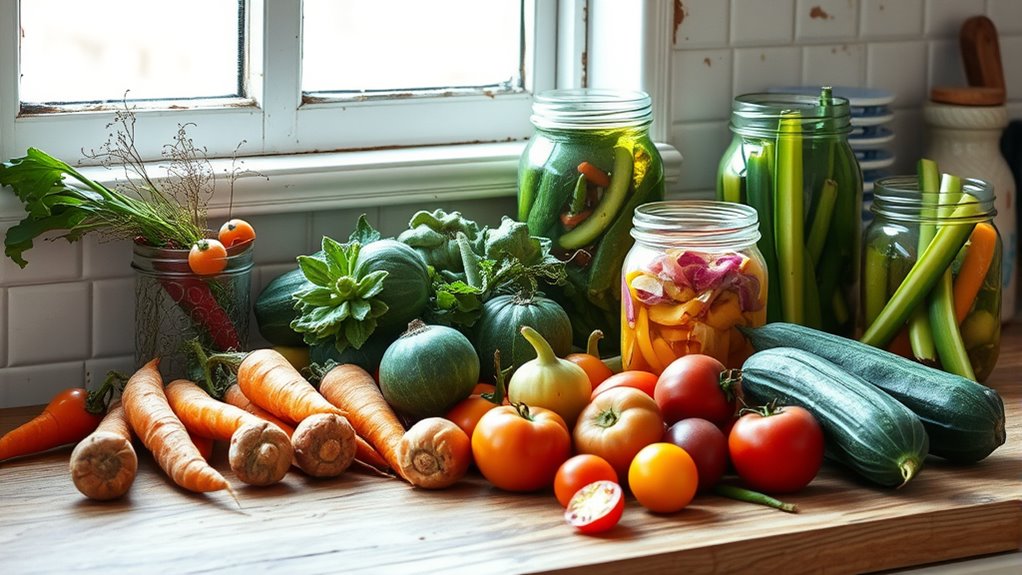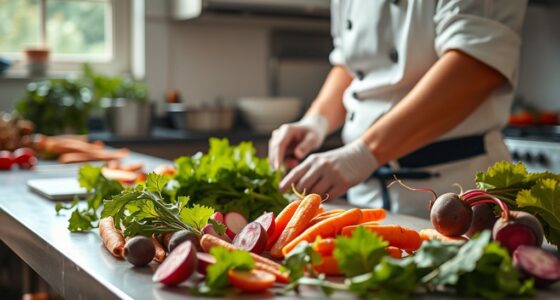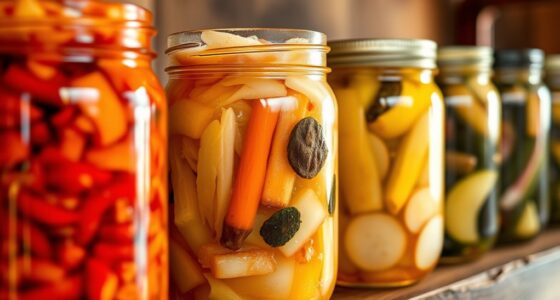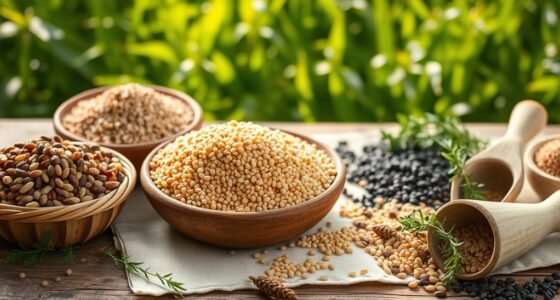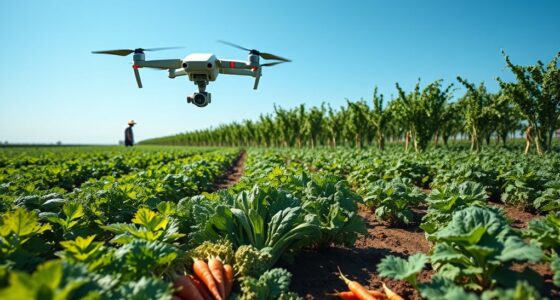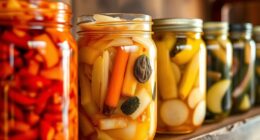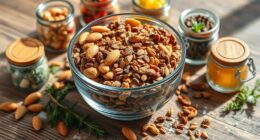Upcycling produce reduces food waste by transforming imperfect or surplus fruits and vegetables into new, valuable products like jams, smoothies, or snacks, instead of letting them spoil. This practice keeps edible food out of landfills, where it produces harmful methane gas, and minimizes resource use like water and land. By finding creative ways to reuse excess produce, you help lower environmental impact and support sustainability efforts. Keep exploring to discover more ways you can make a difference.
Key Takeaways
- Upcycling transforms surplus or imperfect produce into new products, preventing them from ending up in landfills.
- It reduces food waste by extending the usability and shelf life of fruits and vegetables.
- Upcycling decreases resource consumption by repurposing produce instead of discarding it, conserving water, land, and energy.
- It promotes sustainable practices that minimize environmental impact and greenhouse gas emissions from decomposing waste.
- Upcycling supports community efforts to reduce food waste through creative reuse and local distribution of surplus produce.
The Environmental Impact of Food Waste
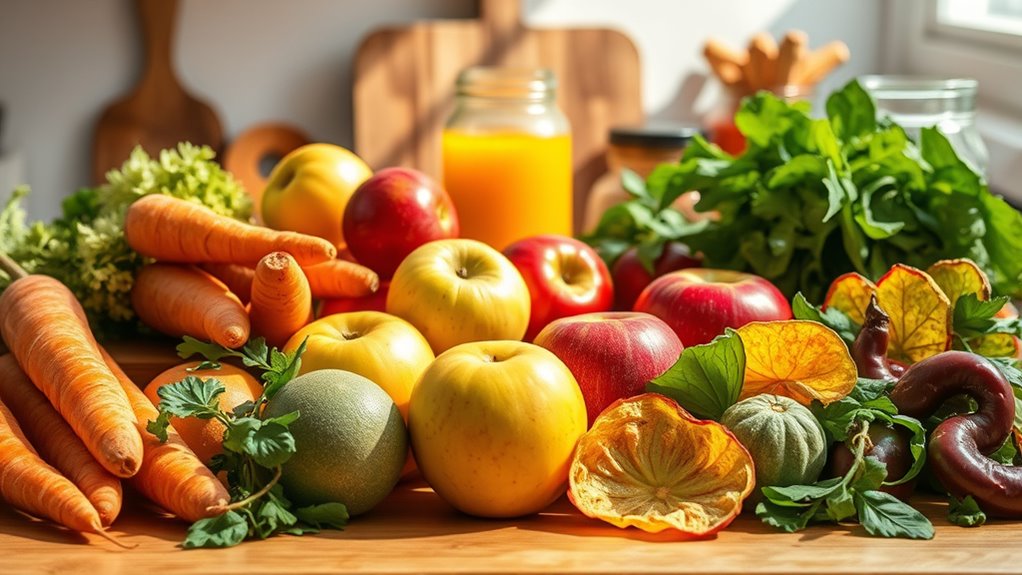
Food waste considerably harms the environment because when produce is discarded, it often ends up in landfills where it decomposes and releases methane, a potent greenhouse gas. According to food waste statistics, about one-third of all food produced globally gets wasted, markedly increasing ecological footprints. This excess waste requires additional resources like water, land, and energy to produce, only for it to be thrown away. As a result, you contribute to environmental degradation through unnecessary greenhouse gas emissions and resource depletion. Reducing food waste not only lessens your ecological footprint but also helps mitigate climate change. Implementing sustainable practices such as upcycling produce can significantly reduce the amount of food that goes to waste and lessen environmental impacts. Recognizing the impact of resource-intensive food production can motivate more sustainable choices. Additionally, understanding food waste’s environmental costs can encourage individuals and businesses to adopt more mindful consumption habits. By understanding these impacts, you can make more conscious choices to prevent waste and support sustainable practices, thereby promoting environmental sustainability.
The Concept and Benefits of Upcycling Produce
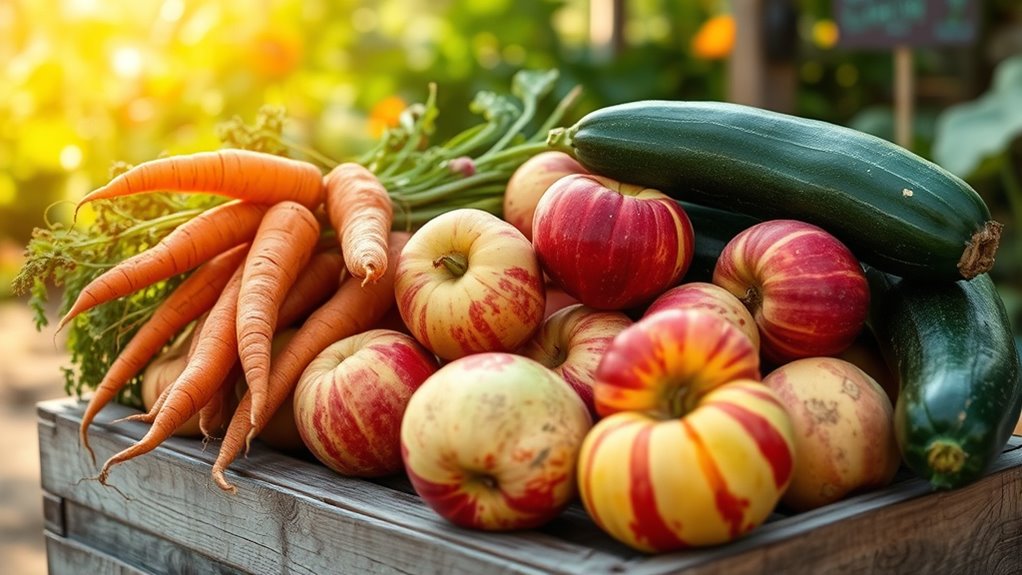
Upcycling produce involves transforming surplus fruits and vegetables into new, useful products, reducing waste and maximizing resources. By doing so, you can help lower the environmental impact of food waste and promote sustainability. Embracing this creative approach benefits both the planet and your efforts to reduce waste. Developing conflict resolution skills can also improve communication and foster stronger connections when working on upcycling projects with others. Utilizing innovative gardening tools, such as specialized planters, can further support sustainable practices and efficient resource use in your gardening endeavors. Incorporating knowledge about astrology & attractiveness may inspire creative ways to approach food presentation and aesthetic appeal in your upcycled creations, blending science and art. Additionally, exploring best grocery savings strategies can help you allocate resources more effectively and support your sustainability goals.
Creative Use of Surplus
When surplus produce goes unused, it often ends up wasted, but there’s a creative way to give it new life. Upcycling offers innovative solutions that benefit communities and reduce waste. You can transform imperfect fruits and vegetables into jams, smoothies, or pickles, or donate them to local food programs. These efforts support community composting initiatives and provide nutritious options for those in need. By thinking creatively, you extend the produce’s usefulness and prevent unnecessary disposal. Engaging in food waste reduction practices can further maximize the positive impact of upcycling efforts. Additionally, understanding vehicle tuning techniques can inspire more sustainable transportation choices that reduce environmental impact. Incorporating email marketing strategies can also help spread awareness about food waste reduction initiatives and encourage community participation. Recognizing community resilience is essential when organizing collective efforts to combat food waste and promote sustainability. Here’s a quick idea chart:
| Use Idea | Community Benefit | Suitable Produce |
|---|---|---|
| Make jams or sauces | Supports local food programs | Overripe berries, tomatoes |
| Create smoothies | Reduces waste, nutritious | Slightly bruised fruit |
| Donate surplus items | Helps community members | Excess produce |
| Compost scraps | Enriches local soil | Peels, stems |
Environmental Impact Reduction
By rethinking how we handle surplus produce, you can considerably reduce environmental impact. Upcycling produce minimizes waste that would otherwise end up in landfills, where it releases methane, a potent greenhouse gas. It also supports sustainable farming practices by encouraging smarter resource use and reducing the need for excessive agricultural inputs. Additionally, upcycled produce often promotes better composting practices, turning imperfect items into valuable soil amendments. Incorporating vertical storage solutions in food storage can help manage surplus produce by maximizing space and decreasing spoilage. Specifically, you can:
- Reduce methane emissions by diverting surplus produce from landfills
- Promote sustainable farming practices that conserve resources
- Enhance composting efforts, turning waste into nutrient-rich soil
- Recognize the nutritional value of upcycled produce, ensuring that even surplus items retain their health benefits
Together, these actions create a cycle that supports environmental health, cuts down on waste, and fosters a more sustainable food system.
Common Imperfect or Surplus Fruits and Vegetables Suitable for Upcycling
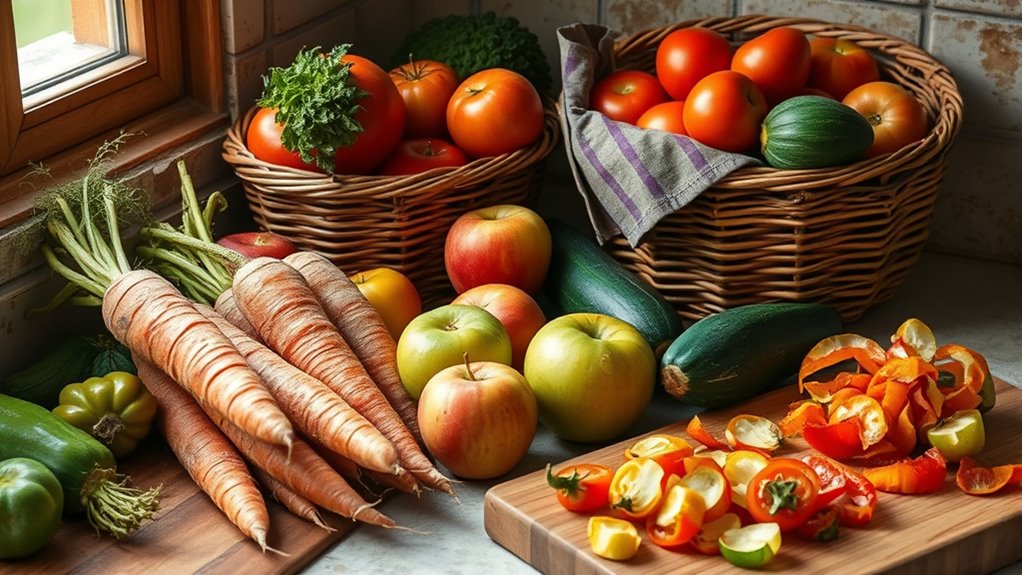
You probably see surplus fruits and vegetables in grocery stores or markets every day. Imperfect produce, like misshapen apples or oddly colored carrots, often gets overlooked but is perfect for upcycling. Using these items not only reduces waste but also creates delicious, resourceful creations. Incorporating upcycled produce into your diet can contribute to sustainable food sources and promote environmental conservation. By choosing to upcycle these items, you support ethical food practices that prioritize reducing food waste and minimizing environmental impact. Additionally, embracing personal development techniques such as mindfulness and goal setting can enhance your commitment to sustainable living practices. Implementing color accuracy principles can also help in selecting the best produce for visual appeal and presentation in creative dishes.
Common Surplus Fruits
Have you ever noticed how many imperfect or surplus fruits and vegetables end up discarded despite being perfectly edible? Common surplus fruits often include bananas with minor blemishes, apples with slight bruises, and peaches that are overly ripe. These fruits are ideal for upcycling because they retain flavor and can be transformed into delicious products. When upcycled, you guarantee:
- Flavor preservation, making smoothies, jams, or baked goods taste just as good.
- Minimal aesthetic compromise, as imperfections don’t affect taste or nutritional value.
- Waste reduction, reducing the environmental impact of discarded produce.
- Proper handling and storage practices enhance the freshness and prolong the usability of surplus produce. Additionally, employing farm-to-table cooking techniques can maximize the use of seasonal surplus ingredients, further reducing waste.
Imperfect Produce Options
Many imperfect or surplus fruits and vegetables are perfect candidates for upcycling, even if they don’t look picture-perfect. Imperfect produce, such as misshapen carrots, bruised apples, or oddly shaped zucchinis, often gets discarded despite being perfectly edible. These surplus fruits and vegetables may not meet retail standards but still pack all the flavor and nutrients. By choosing to upcycle imperfect produce, you reduce food waste and make the most of what would otherwise go to waste. You can incorporate these surplus fruits into smoothies, jams, soups, or baked goods. Upcycling imperfect produce helps you save money, supports sustainable practices, and contributes to a more efficient food system. Don’t overlook the beauty and potential of these less-than-perfect fruits and vegetables—they’re just waiting to be transformed.
Creative Ways to Transform Produce Into New Products
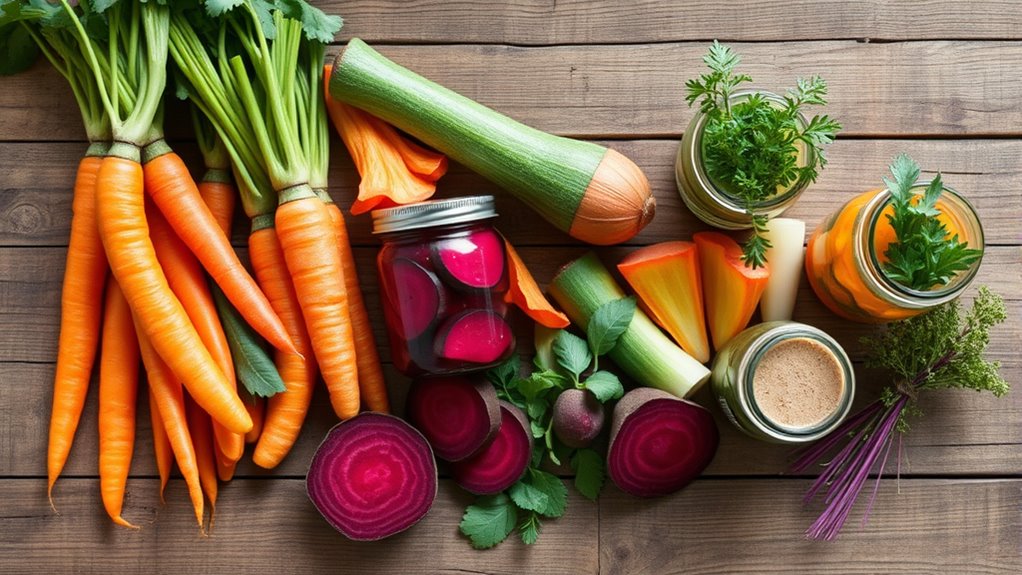
Even with excess produce, there’s no need to let it go to waste; instead, you can get creative and transform it into a variety of new products. Start by exploring simple ideas like making smoothies or jams, which preserve flavor and extend usability. You can also repurpose scraps into compost, supporting sustainable gardening with proper composting methods. Additionally, invest in kitchen gadgetry, such as spiralizers or dehydrators, to create veggie noodles or dried fruit snacks. These tools make it easy to craft snacks and ingredients for future meals. By experimenting with these techniques, you reduce waste while adding nutritious, homemade items to your diet. This approach not only minimizes discard but also encourages innovation in how you utilize produce.
How Consumers Can Incorporate Upcycling Into Daily Life
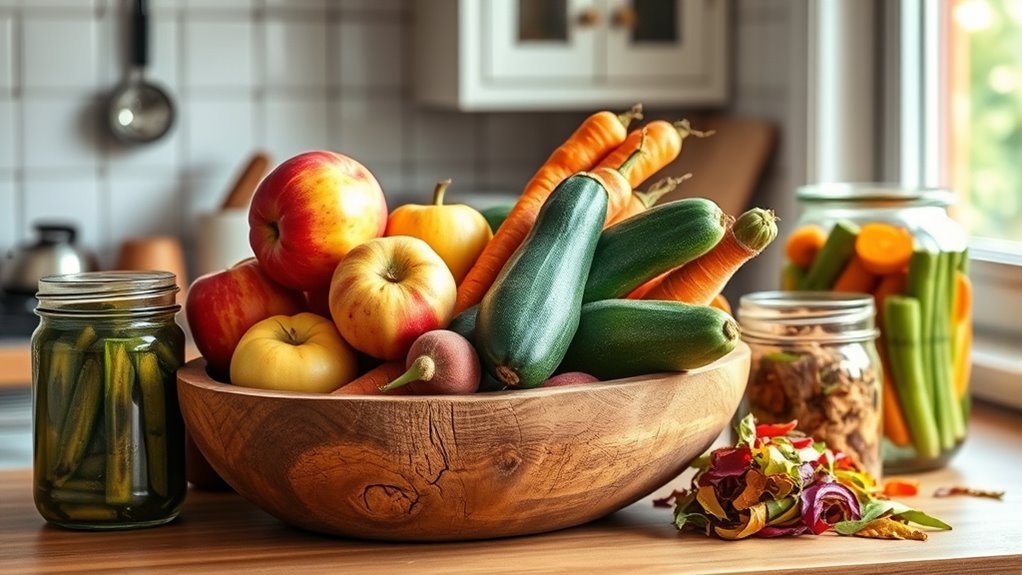
Integrating upcycling into your daily routine is simpler than you might think. Start with small recycling tips, like saving vegetable scraps for broths or composting peels and stems. Use leftovers creatively to minimize waste, turning overripe fruits into smoothies or baked goods. Incorporate upcycled produce into your menus by buying imperfect or cosmetically damaged items at local markets. Keep reusable bags and containers handy to reduce packaging waste. Establish daily practices that prioritize mindful shopping—planning meals around what’s available and reducing impulse buys. By making these habits routine, you actively contribute to reducing food waste. These small but consistent actions not only help the environment but also develop a sustainable mindset that values upcycling in everyday life.
Business Opportunities in Upcycling Produce
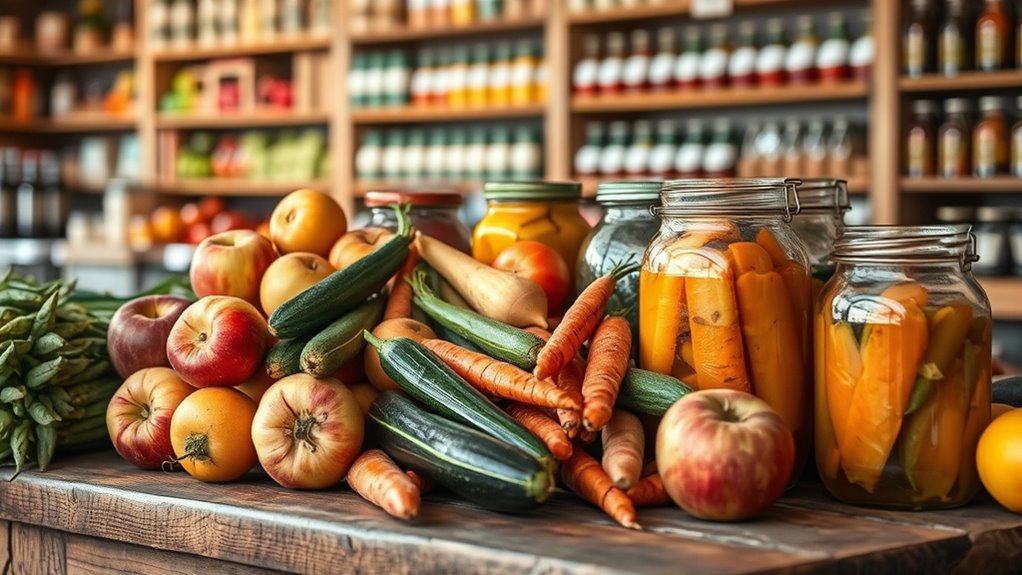
Upcycling produce opens up a range of innovative business opportunities for entrepreneurs passionate about sustainability. You can differentiate your venture by focusing on local farmers markets, where fresh, imperfect produce can be sold directly to consumers. Additionally, investing in packaging innovation allows you to create eco-friendly, attractive packaging that highlights your commitment to reducing waste. Here are some ideas to explore:
- Develop specialty products like jams or snacks using surplus produce, appealing to eco-conscious buyers.
- Offer upcycled produce at farmers markets, emphasizing freshness and sustainability.
- Implement innovative packaging solutions that minimize waste and enhance shelf appeal, setting your brand apart.
Future Trends and Innovations in Food Waste Reduction
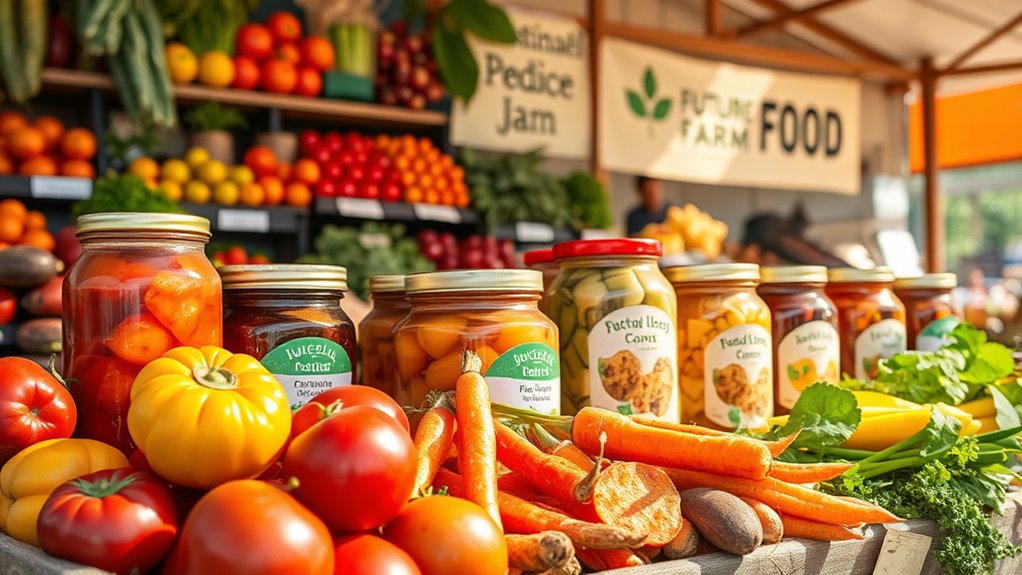
As technology advances, innovative solutions are emerging to drastically reduce food waste across the supply chain. You’ll see breakthroughs in areas like innovative packaging, which extends produce shelf life and reduces spoilage. Supply chain optimization also plays a key role, using AI and data analytics to improve logistics and demand forecasting. To visualize, consider this table:
| Current State | Future Innovation |
|---|---|
| Excess produce waste | Smart packaging solutions |
| Manual inventory checks | Automated, real-time tracking |
| Supply chain delays | AI-driven logistics |
| Spoilage at retail | Predictive freshness tech |
These trends make it easier for you to minimize waste, save resources, and create a more sustainable food system.
Frequently Asked Questions
How Does Upcycling Produce Influence Local Economies?
Upcycling produce boosts local economies by creating new job opportunities and supporting small businesses. It enhances food security by making use of imperfect or surplus produce, reducing waste. As a consumer, your increased awareness encourages sustainable choices, which in turn drives demand for upcycled products. This cycle strengthens local markets, promotes eco-friendly practices, and fosters community resilience, making your support essential in shaping a more sustainable and economically vibrant environment.
What Safety Standards Are Required for Upcycled Produce Products?
Like a vigilant guardian, food safety standards protect your upcycled produce. You must guarantee regulatory compliance by adhering to local health regulations, implementing proper sanitation, and using safe handling practices. Certifications like HACCP or organic labels symbolize trust. By maintaining these standards, you safeguard consumers and uphold quality, turning what could be waste into a symbol of sustainability and responsibility, emphasizing that safety is the cornerstone of successful upcycling efforts.
Can Upcycled Produce Be Used in Institutional Food Service Settings?
You can definitely use upcycled produce in institutional food service settings, but consider consumer acceptance and supply chain integration. When you introduce upcycled items, guarantee they meet safety standards to build trust. By effectively integrating suppliers and educating diners on the benefits, you’ll foster acceptance and create a sustainable, innovative menu that reduces waste and appeals to environmentally-conscious consumers.
How Does Upcycling Compare Cost-Wise to Traditional Produce Sourcing?
Think of upcycled produce as a hidden treasure chest—you might find it costs less than traditional sourcing. When you compare costs, you’ll discover upcycling often offers a favorable cost comparison, reducing expenses and boosting your economic impact. For example, some programs cut food costs by 20%, helping your budget stretch further. Overall, upcycled produce can be a smart, budget-friendly choice that benefits both your wallet and sustainability goals.
Are There Specific Policies Supporting Upcycling Initiatives?
You’ll find that policy incentives and regulatory frameworks play a key role in supporting upcycling initiatives. Governments and organizations often offer grants, tax breaks, or streamlined permits to encourage upcycling efforts. These policies make it easier for you to implement and expand upcycling projects, reducing barriers and fostering innovation. By advocating for stronger policy incentives, you help create a more sustainable system that benefits both producers and the environment.
Conclusion
So, next time you see those oddly shaped apples or bruised bananas, remember—they’re just begging for a second chance. Upcycling produce isn’t just eco-friendly; it’s a stylish way to turn kitchen scraps into gourmet delights. Who knew reducing food waste could be so creative? So go ahead, embrace the imperfect—because saving the planet has never looked so delicious, or so amusingly rebellious. Waste less, eat better, and maybe, just maybe, become a food hero.
Aurelia is the Editor-in-Chief of The Graceful Kitchen, a vegan lifestyle blog that focuses on delicious, nutritious, and ethical eating. A lifelong vegan, Aurelia is passionate about sharing her love of plant-based cuisine with others. She is a regular contributor to several online and print publications, and has been interviewed by major news outlets about the benefits of a vegan diet. In her free time, Aurelia enjoys cooking, hiking, and spending time with her cats.
